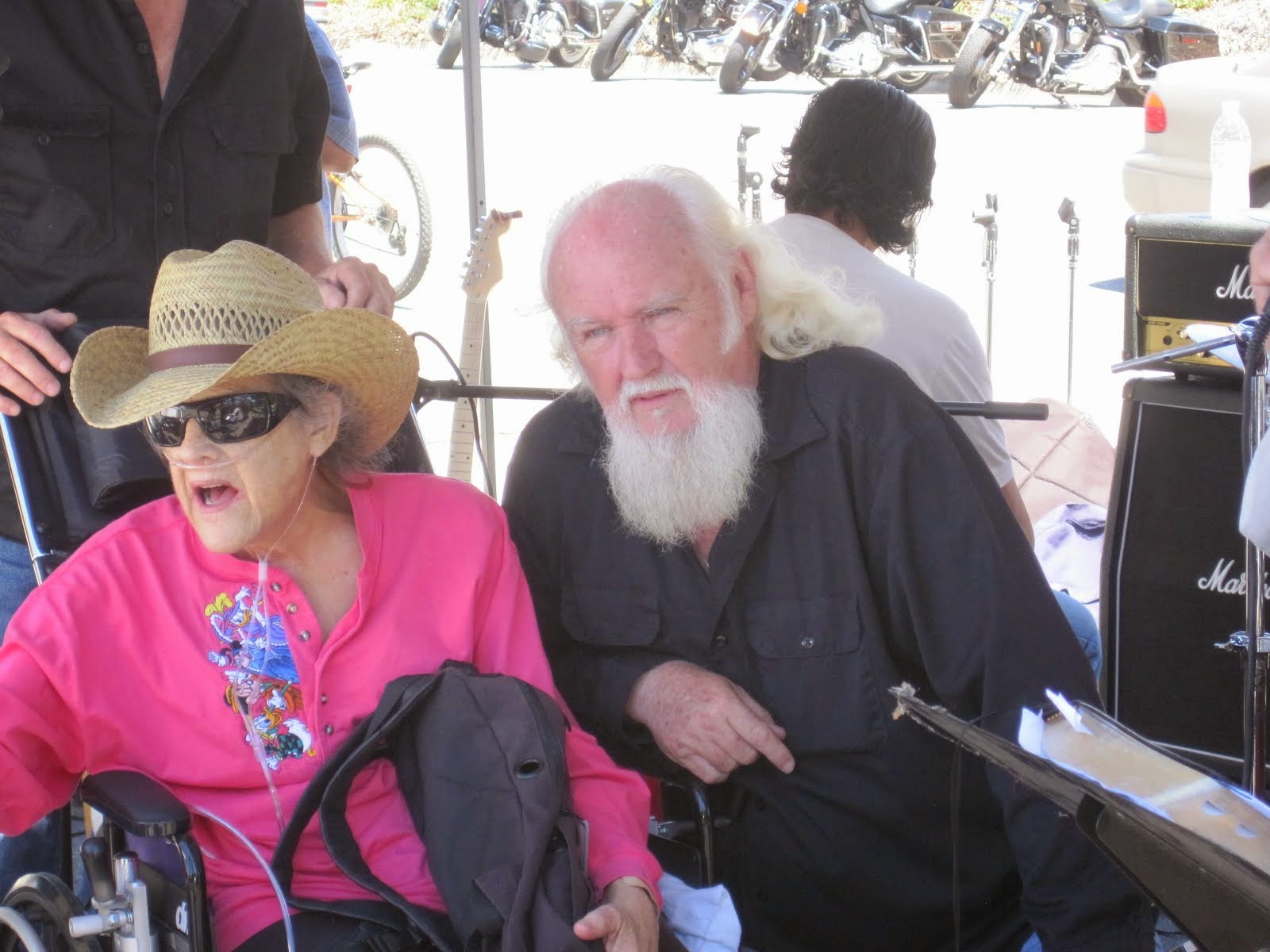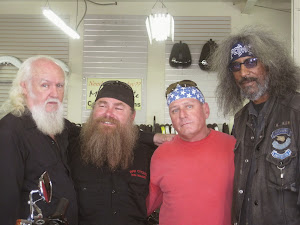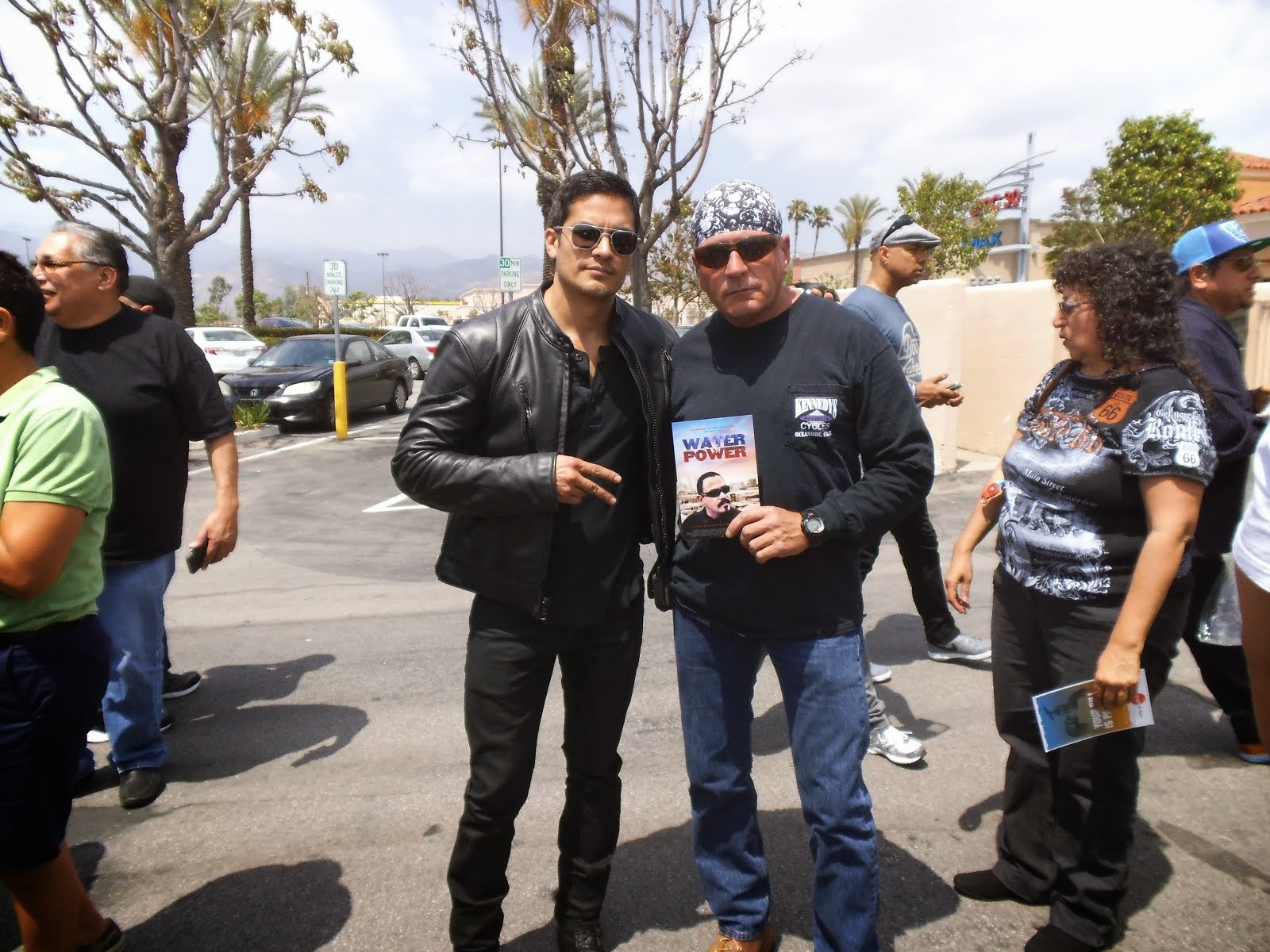OFF THE WIRE
Give me a #%&#%^% break. Control meth n Ga. You need to get your info straight before you print your cop shit. About half of this whole story might have a little truth to it.
You people are NUTS! Where do you make this shit up? Do you actually belive this NONSENSE??????????????????? Unbelievable. You guys are on some SERIOUS drugs, you have to be.
By Don Kelley, Probation and Parole Supervisor,
Montana Department of CorrectionsGang issue reaches into corrections - Part IV
This five part series is intended to provide insight into the history, function and hierarchy of some of the most violent of worlds.
This installment deals with the motorcycle clubs with the largest presence in Montana. Recent law enforcement interdiction has caused considerable difficulties among the bikers, but did not eliminate their presence or eradicate the majority of the members.
The Bandidos recently were involved in an “internal cleansing” in which the presidency returned from Seattle to Texas and the groups expanded its territory.
The Mongol nation has a strong presence in Helena as well as Philipsburg. A recent incident in Philipsburg resulted in Mongol member stabbing a man six times in a brawl over a former girlfriend.
The Outlaw nation recently was the target of a national crackdown by the U.S. Bureau of Alcohol, Tobacco, Firearms and Explosives that involved the group’s state president in Livingston. Other chapters are located in Bozeman and Butte. The ATF investigation into the Montana members continues.
The Bandidos club was formed in 1966 in Houston by Donald Eugene Chambers. He created the outlaw motorcycle club to control drug trafficking and prostitution in Texas. He saw a TV commercial with the Frito Bandido hawking the popular corn chips. The cartoon character robbed people of their Fritos and complained about being pursued by the “Frito Bureau of Investigation.”
Chambers called his gang the Bandidos and adopted a fat, machete- and pistol-wielding version of the animated bandit as the club’s colors.
The Bandidos, also called the Bandido Nation, are the fastest-growing outlaw motorcycle gang in the country. The club has about 30 chapters and 500 members. It even has Australian and European chapters, acquired with much bloodletting.
The Bandidos are involved in drug trafficking, prostitution, contract murder, fencing, extortion, stealing and running weapons, welfare and bank fraud, and arson. The bikers make most of their money manufacturing and selling methamphetamine. Club members and associates who are pilots smuggle drugs and guns across the border and state lines.
The Nomad chapter handles Bandido security and internal discipline. The chapter is made up of charter members who have been with the club for more than five years. The chapter compiles files on police forces and outlaw motorcycle gangs they consider to be enemies.
The Bandidos’ alliance with the Outlaws began in 1978 in an effort to expand their drug network. The Outlaws provide the Bandidos with cocaine they obtained from Colombian and Cuban suppliers. Both clubs socialize in Bandido- controlled towns.
The Outlaws Motorcycle Club, also called the American Outlaw Association, was founded by John Davis in 1959 in Chicago. The club has about 34 chapters in the United States and Canada, with about 900 members. Detroit has been the “mother chapter” since 1984. It changed from Chicago when a new national president was elected.
The club rallies under the Outlaws’ colors, affectionately known as Charlie. Charlie is a white skull with crossed pistons on a black background. The skull has beady red eyes, which are supposed to watch for trouble behind the wearer’s back. The pistons are outlined in red. The skull is borrowed from the back of Marlon Brando’s black leather Jacket in the 1953 bikegang movie, “The Wild One.”
The club motto is simple: “God forgives, Outlaws don’t.”
While Outlaw chapters operate independently, regional and national officers control drug trafficking, relations with other motorcycle gangs and the distribution of the club’s profits. The Outlaws are involved in extortion, contract murders, motor vehicle thefts, gun and explosives running, armed robbery, rape and mail fraud in addition to drug trafficking and prostitution.
Outlaw members must sell drugs and own at least one handgun. Members work in pairs to avoid screw-ups and to avoid situations where the club can lose face. A lone biker is considered a tempting target for punks trying to impress each other.
Drug selling is the Outlaws’ main source of income. “Canadian Blue,” which refers to diazepam (Valium), is manufactured in clandestine Ontario laboratories and smuggled across the border, usually to Chicago. It is distributed from Chicago to different chapters. Some pay cash for the drugs, others trade weapons, women or methamphetamine.
The Florida chapters buy the club’s cocaine from Colombian and Cuban suppliers. The Outlaws also manufacture and distribute cocaine and methamphetamine in the Fort Lauderdale area. They own property in South Florida where smugglers dock and unload their boats. The Milwaukee chapter controls the methamphetamine market in Wisconsin. The Outlaws also control methamphetamine laboratories in Georgia.
The Mongols Motorcycle Club, or Mongol Nation, formed in Montebello, Calif., in 1969 and was named after the nomadic tribes of northeast Asia. Original members reportedly were disgruntled Vietnam-era veterans. During the 1960s, The Hells Angels would not allow Hispanics into the club simply due to their race and the Mongols supposedly formed in response to that restriction.
Approximately 650 Mongols, or “full patches,” operate in the United States. The Mongols are friendly with the Outlaws due to a mutual hatred for the Hells Angels. A confrontation between the Hells Angels and the Mongols at Harrah’s Casino in Laughlin, Nev., on April 27, 2002, left two Hells Angel and one Mongol dead.
William Queen, an ATF agent who infiltrated the Mongols in 1998, wrote a very good book about the club called Under and Alone. He describes his two-year life with the Mongols. Resulting federal indictments of 54 Mongol members led to all but one of them being convicted.
In 2008, the Mongols again were infiltrated by the ATF. The investigation culminated in over 100 arrest warrants and over 150 search warrants. Another result was the barring of club members from wearing or displaying club colors, and the conviction of many in leadership.
A federal magistrate found the club to be a criminal organization that used the “colors” to identify other members. The judge’s ruling was overturned on appeal and the right of club members to wear their colors was restored.
The mayor of Lancaster, Calif., perhaps stated it most accurately in describing the club this way: “They are engaged in domestic terrorism … and plan to kill our children.”
EDITOR’S NOTE: This is the fourth in a series of articles, reprinted with permission, about street gangs and motorcycle clubs in Montana, issues for both correctional officers and probation and parole officers.
http://www.corrections.com/news/article/25850-three-bike-gangs-dominate-montana
Part I - Street Gangs Got Start in L.A.
Part II - Gangs Lure Members in Getting Foothold
Part III - Biker Gangs Have Deep Roots .
skip to main |
skip to sidebar




Bill & Annie

Art Hall & Rusty


NUFF SAID.......


































































OOHRAH

ONCE A MARINE,ALWAYS A MARINE

GIVING BACK


MOUNT SOLEDAD














BIKINI BIKE WASH AT SWEETWATER










FRIENDS





BILL,WILLIE G, PHILIP










GOOD FRIENDS


hanging out

brothers


GOOD FRIENDS

Good Friends

Hanging Out




Bill & Annie
Art Hall & Rusty
Art Hall & Rusty


NUFF SAID.......



















NUFF SAID......



























Mount Soledad




BALBOA NAVAL HOSPITAL
RUSTY DANNY

ANNIE KO PHILIP

PHILIP & ANNIE

OUT & ABOUT

OOHRAH...

OOHRAH
ONCE A MARINE,ALWAYS A MARINE

ONCE A MARINE,ALWAYS A MARINE
American Soldier Network GIVING BACK

GIVING BACK
CATHY & BILL
PHILIP & DANNY & BILL

MOUNT SOLEDAD
bills today
EMILIO & PHILIP
WATER & POWER
WATER & POWER
bootride2013



BIKINI BIKE WASH AT SWEETWATER







ILLUSION OPEN HOUSE

FRIENDS


GOOD FRIENDS



BILL,WILLIE G, PHILIP









GOOD FRIENDS

GOOD FRIENDS
Friends
- http://www.ehlinelaw.com/losangeles-motorcycleaccidentattorneys/
- Scotty westcoast-tbars.com
- Ashby C. Sorensen
- americansoldiernetwork.org
- blogtalkradio.com/hermis-live
- davidlabrava.com
- emiliorivera.com/
- http://kandymankustompaint.com
- http://pipelinept.com/
- http://womenmotorcyclist.com
- http://www.ehlinelaw.com
- https://ammo.com/
- SAN DIEGO CUSTOMS
- www.biggshd.com
- www.bighousecrew.net
- www.bikersinformationguide.com
- www.boltofca.org
- www.boltusa.org
- www.espinozasleather.com
- www.illusionmotorcycles.com
- www.kennedyscollateral.com
- www.kennedyscustomcycles.com
- www.listerinsurance.com
- www.sweetwaterharley.com

Hanging out

hanging out
Good Friends

brothers
GOOD FRIENDS

EMILIO & SCREWDRIVER

GOOD FRIENDS
Danny Trejo & Screwdriver

Good Friends
Navigation
Welcome to Bikers of America, Know Your Rights!
“THE BIKERS OF AMERICA, THE PHIL and BILL SHOW”,
A HARDCORE BIKER RIGHTS SHOW THAT HITS LIKE A BORED AND STROKED BIG TWIN!
ON LIVE TUESDAY'S & THURDAY'S AT 6 PM P.S.T.
9 PM E.S.T.
CATCH LIVE AND ARCHIVED SHOWS
FREE OF CHARGE AT...
BlogTalkRadio.com/BikersOfAmerica.
Two ways to listen on Tuesday & Thursday
1. Call in number - (347) 826-7753 ...
Listen live right from your phone!
2. Stream us live on your computer: http://www.blogtalkradio.com/bikersofamerica.
A HARDCORE BIKER RIGHTS SHOW THAT HITS LIKE A BORED AND STROKED BIG TWIN!
ON LIVE TUESDAY'S & THURDAY'S AT 6 PM P.S.T.
9 PM E.S.T.
CATCH LIVE AND ARCHIVED SHOWS
FREE OF CHARGE AT...
BlogTalkRadio.com/BikersOfAmerica.
Two ways to listen on Tuesday & Thursday
1. Call in number - (347) 826-7753 ...
Listen live right from your phone!
2. Stream us live on your computer: http://www.blogtalkradio.com/bikersofamerica.
Good Times
Hanging Out

Key Words
- about (3)
- contact (1)
- TENNESSEE AND THUNDER ON THE MOUNTAIN (1)
- thinking (1)
- upcoming shows (2)
Blog Archive
-
▼
2010
(4242)
-
▼
December
(595)
- No title
- Canada - TRURO - Startling developments in decade-...
- LOCALS FORGE LAW TO FIGHT MOTORCYCLE THEFT
- DUI - Do you feel your state DUI laws are too stiff?
- Policing the police: No oversight - 2nd Installmen...
- With ‘Sovereign Citizen’ Movement Growing, New SPL...
- UPCOMING EVENTS
- Two indicted on gang-related charges
- FUCK YOU ! Neither 'good' nor 'bad,' fatal police ...
- Fiber Optic Mohawk Helmets. Not For Me. For You?
- CA: Drivers Angered by Freeway Campaign Promoting ...
- JUSTICE DENIED FOR A DISABLED VIETNAM ERA VETERAN ...
- National Police Misconduct NewsFeed Daily Recap 12...
- Canada - Whynott to make court appearance this aft...
- Georgia - Biker babes aid troops, charity
- Scott City, MO - Boot-Heel Harley-Davidson Gives T...
- Australia - Sydney tattoo parlour firebombed
- Australia -Sad loss of a charitable man
- Maine AG: ATF agents justified in shooting biker.....
- California - New state law aims to curb motorcycle...
- Missouri - Patriot Guard bikers proud to block Wes...
- Pro-Gun Argument . . .
- CALIFORNIA - New Motorcycle Law Revs Up Controvers...
- F.Y.I. - FREEDOM OF INFORMATION ACT.......
- Australia - Rival bikie gangs up the ante - Coman...
- National Police Misconduct NewsFeed Daily Recap 12...
- WASHINGTON - DEA transformed into global intellige...
- PROJECT - " NOT GIULTY "
- Happy New Year and Mark Your Calendars for the 201...
- A Premature Alarm Regarding Police Fatality Rates
- FABIAN v. FULMER HELMETS, INC.
- House Checks?
- PROJECT - " NOT GIULTY "
- UNITED STATES - Feds To Require Gun Sale Notificat...
- HARLEY RIM FAILURE!
- Arizona - KINGMAN - 7 alleged Vagos indicted
- The FCC's Threat to Internet Freedom
- 2010 Motorcycle Helmet laws a federal issue again???
- New state laws change rules on drinking, handgun a...
- Scientific Research,Study: Fellatio may significan...
- Back-seat Driver: California toughens motorcycle l...
- ATTIKA7
- New legislation that could potentially affect MC p...
- “THE BIKERS OF AMERICA - THE PHIL AND BILL SHOW”
- California - Santa Clara cop now faces federal cha...
- BOLT of Iraq???
- Last Night's Activism
- Germany - Hells Angels on the rise
- ~ Living Legends ~ Lithograph & Book Signing
- LINKS TO SHARE:
- FABIAN v. FULMER HELMETS, INC.
- U.S. - Monitoring America - "See Something, Say S...
- TENNESSEE: Appeals court orders reconsideration of...
- Pittsburgh officer charged in fatal Sept. crash
- KENTUCKY: This years Ride for Freedom 2011 will be...
- VETERANS BENEFITS ACT OF 2010 SIGNED INTO LAW.
- January 8, 2011 Los Angeles, CA Easyriders Bike Sh...
- More rights stolen!! Now it's the internet!! Thank...
- Washington DC - House to read Constitution - 'We t...
- Fourth Amendment Rights
- Federal helmet recommendation could affect motorcy...
- Motorcycle Helmet laws a federal issue again???
- Off-duty San Diego police officer shoots suspect t...
- New legislation that could potentially affect MC p...
- MEMPHIS, Tenn. (AP) — An appeals court has ruled t...
- Cops' Use of Illegal Steroids a 'Big Problem'
- California Gun Laws: APPEAL FILED IN LAWSUIT CHALL...
- “HERMIS LIVE!”-INTERNET RADIO SHOW-BIKERS: MODERN ...
- OUT OF CONTROL - Cheektowaga, NY - Use of Taser br...
- Winter Motorcycle Tire Tips From Dunlop
- Oklahoma - Police corruption probe to deepen in 2011
- Harley-Davidson, Inc. to report fourth quarter ear...
- UPDATE - Top stories of 2010
- Cyprus - Bikie paymaster faces extradition
- UPDATE - Outlaw bikers convicted in RICO case
- UPDATE - Sex trafficking victims at massage parlor...
- A massage parlor eviction incident in Irvine, CA r...
- HPD Officer Probed in Pill Mill
- Georgetown man says police officer kicked him, bro...
- Pocono, PA - Angels in leather embody spirit of Ch...
- Australia - Rebels bikie citadel up for sale
- California - Former Bell Cop Gets Nine Years in Pr...
- Australia - Christmas party like no other..........
- Australia - Top fugitive nabbed in Cyprus
- National Police Misconduct NewsFeed Daily Recap 12...
- AMA ACTION ALERT - New Omnibus Public Lands Bill i...
- Australia - Bikie sign a hoax: owners
- IMPORTANT NEWS - CNN Breaking News House OKs measu...
- Australia - Gunman 'was taking shots at strip club'
- New rules may result in no fireworks
- INTERNATIONAL NEWS: Jamaica - Police get motorcyc...
- Biker/Santa inspires Club to Hold Toy Drive....
- IOWA: Motorcycle helmets should be required by law
- Australia - Alleged biker bans himself from pubs
- Outlaws Motorcycle Gang Members Found Guilty
- New York - Celebration to recall life of Fran Zygl...
- CHARLESTON, W.Va. - Former prison guard sentenced ...
- CHARLESTON, W.Va - Man who sold cocaine to Pagans ...
- INTERNATIONAL NEWS: Jerusalem - Avi Cohen's injury...
- Illinois - CHICAGO - 'Large Guy' convicted in Chic...
-
▼
December
(595)
Bikers of America, Know Your Rights!... Brought to you by Phil and Bill
Philip, a.k.a Screwdriver, is a proud member of Bikers of Lesser Tolerance, and the Left Coast Rep
of B.A.D (Bikers Against Discrimination) along with Bill is a biker rights activist and also a B.A.D Rep, as well, owner of Kennedy's Custom Cycles
